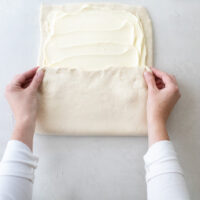
Foolproof Cheater Croissant Dough
Anyone can make flaky, delicious croissants with this cheater dough recipe! Butter is spread over the surface of the dough and then folded instead of using a butter block. The dough is lovely to work with and can be used to make delectable pastries.
Servings 2 1/2 pounds of dough
Ingredients
- 1½ cups [360 g] warm water (100 to 110°F [35 to 42°C]
- 1 tablespoon plus 1 teaspoon active dry yeast
- 4 cups plus 1 tablespoon [577 g] all-purpose flour, plus more for dusting
- ¼ cup plus 1 tablespoon [65 g] granulated sugar
- 2 teaspoons salt
- 2 tablespoons unsalted butter, melted
- 1½ cups [3 sticks or 339 g] unsalted European butter (preferably 82 percent butterfat), at room temperature (68°F [20°C] and pliable
Instructions
- Grease a large bowl and set aside. In a small bowl or liquid measuring cup, stir together the water and yeast and let sit until dissolved, about 5 minutes.
- In the bowl of a stand mixer fitted with the hook, mix together 4 cups [568 g] of the flour, granulated sugar, and salt. Start the mixer on low speed and add the water-yeast mixture, followed by the melted butter. Continue to mix until all the ingredients are combined, 3 or 4 minutes (see notes). The dough will be rough and bumpy but should be in one piece. Move the dough to the large greased bowl and cover with plastic wrap. Let the dough rise at room temperature for 1½ to 2 hours, until doubled in size.
- Gently press down on the dough, releasing as much gas as possible. Place the dough on a large piece of plastic wrap and shape it into a 10 by 12 in [25 by 30.5 cm] rectangle. Cover the dough with more plastic wrap, place it on a sheet pan, and transfer it to the refrigerator for at least 2 hours and up to overnight.
- In the bowl of a stand mixer fitted with a paddle, beat the European butter and the remaining 1 tablespoon of flour together until creamy and combined, 2 to 3 minutes (see notes).
- Remove the dough from the refrigerator, unwrap it from the plastic, and place it on a lightly floured work surface. Roll the dough into a 12 by 20 in rectangle. Spread the entire rectangle evenly with the butter-flour mixture, leaving a ½ in [12 mm] border around the rectangle. Make the first turn, or letter fold: Starting with a short side facing you, fold one-third of the dough onto itself, making sure the edges are lined up with each other. Then fold the remaining one-third of dough on top of the side that has already been folded. Rotate the dough so the seam is facing to the right and one open end is facing you. Gently roll the dough into a 10 by 18 in [25 by 46 cm] rectangle. (Each time you roll, the rectangle will get a bit smaller.) Repeat the letter fold. Sprinkle flour on a sheet pan or plate, place the dough on it, and freeze the dough for 6 minutes—set a timer so you don’t forget (see notes; this helps cool the dough slightly and makes the last turn less messy).
- Remove the dough from the freezer and repeat the letter fold again, making sure the seam is facing to the right. Roll the dough again into a rectangle, about 8 by 16 in [20 by 40.5 cm]. Repeat the steps for one letter fold. Gently compress the dough with the rolling pin and, depending on the recipe you are using, keep the dough in one piece or cut the dough into two equal portions. If using the dough immediately, place the piece being used in the freezer for 6 minutes to chill, then proceed with the recipe. Otherwise, wrap the dough in plastic wrap, place it in a freezer safe bag, and freeze for up to 2 weeks. The dough can be removed from the freezer the night before using and placed in the refrigerator to thaw.
Notes
Don’t overmix the dough when combining ingredients; this can result in a tough, chewy texture. Make sure the European butter and flour mixture is pliable but not melting; it should have the texture of cream cheese and should spread easily. Don’t forget to remove the dough from the freezer after 6 minutes! If left in longer, the butter will start to freeze and then break apart as it rolls out.
If you forget about the dough in the freezer, let it sit at room temperature for a while until it can be rolled out easily.
The laminating process will help strengthen your dough.